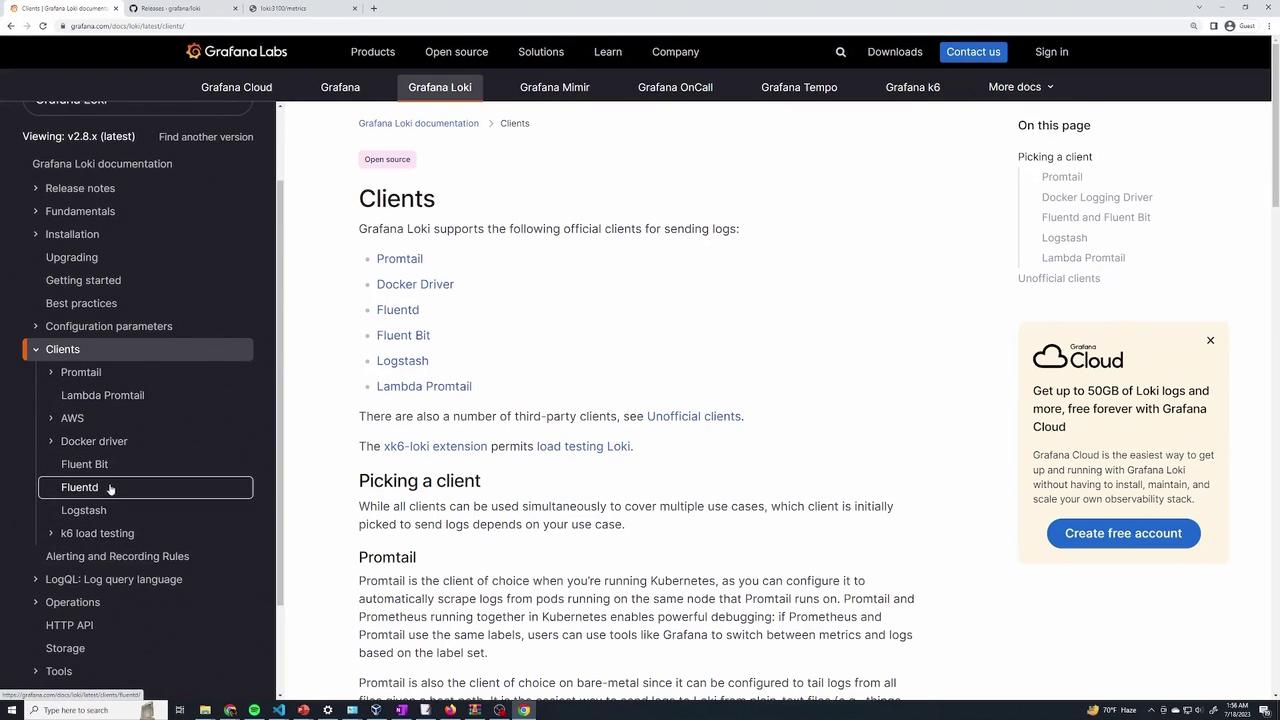Grafana Loki
Grafana Loki Essentials Part 1
Promtail installation
In this guide, we assume your Loki server is already running. Now it’s time to set up Promtail—the dedicated log collection agent—to forward logs from your nodes (node one and node two) to your Loki instance.
Begin by exploring the documentation under the Clients section. Here, you will discover several supported clients such as Promtail, Fluent Bit, Fluentd, and Logstash. For this lesson, our focus is on Promtail.

The documentation offers various example configurations (Docker, Helm on Kubernetes, etc.). However, we are interested in downloading a precompiled binary that corresponds to your system architecture (e.g., Promtail Linux AMD64).

Downloading and Unpacking Promtail
Follow these steps on each node to download and extract the Promtail binary:
On Node One
Download the Promtail zip file using
wget:vagrant@node-1:~$ wget https://github.com/grafana/loki/releases/download/v2.8.2/promtail-linux-amd64.zipList the directory to verify the download:
vagrant@node-1:~$ ls LICENSE README.md app flog flog_0.4.3_linux_amd64.tar.gz generated.log log.gz promtail-linux-amd64.zipUnzip the downloaded file:
vagrant@node-1:~$ unzip promtail-linux-amd64.zip Archive: promtail-linux-amd64.zip inflating: promtail-linux-amd64Verify the extraction:
vagrant@node-1:~$ ls LICENSE app flog_0.4.3_linux_amd64.tar.gz log.gz promtail-linux-amd64.zip promtail-linux-amd64 generated.log
On Node Two
Repeat the download and extraction process:
Download the Promtail zip file:
vagrant@node-2:~$ wget https://github.com/grafana/loki/releases/download/v2.8.2/promtail-linux-amd64.zipVerify the download with a directory listing:
vagrant@node-2:~$ ls LICENSE README.md app flog flog_0.4.3_linux_amd64.tar.gz generated.log log.gz promtail-linux-amd64.zipExtract the archive:
vagrant@node-2:~$ unzip promtail-linux-amd64.zip Archive: promtail-linux-amd64.zip inflating: promtail-linux-amd64Confirm the extraction:
vagrant@node-2:~$ ls app promtail-linux-amd64 promtail-linux-amd64.zip
Note
If you encounter an error on node two regarding the absence of the unzip command, install it using:
vagrant@node-2:~$ sudo apt install unzip
Then, rerun the unzip command.
Obtaining the Promtail Configuration File
Promtail requires a configuration file to determine how logs are collected and where to send them. Follow these steps on your node:
Download the example configuration file from GitHub:
vagrant@node-2:~$ wget https://raw.githubusercontent.com/grafana/loki/main/clients/cmd/promtail/promtail-local-config.yamlOpen the configuration file for review:
vagrant@node-2:~$ vi promtail-local-config.yaml
A typical configuration looks like this:
server:
http_listen_port: 9080
grpc_listen_port: 0
positions:
filename: /tmp/positions.yaml
clients:
- url: http://localhost:3100/loki/api/v1/push
scrape_configs:
- job_name: system
static_configs:
- targets:
- localhost
labels:
job: varlogs
__path__: /var/log/*log
Customizing the Configuration
Review the key sections of the configuration:
- Server: Sets Promtail’s HTTP listening port.
- Positions: Specifies the file to store the last read positions of logs.
- Clients: Defines the Loki server endpoint. Change
localhostto the actual IP address or hostname of your Loki server. - Scrape Configs: Determines which log files are monitored. In the example, all files in
/var/logending with"log"are collected.
For example, after updating with your Loki server's IP address, your configuration might be:
server:
http_listen_port: 9080
grpc_listen_port: 0
positions:
filename: /tmp/positions.yaml
clients:
- url: http://<LOKI_IP_ADDRESS>:3100/loki/api/v1/push
scrape_configs:
- job_name: system
static_configs:
- targets:
- localhost
labels:
job: varlogs
__path__: /var/log/*log
You can add more scrape jobs as needed to monitor and label additional log files.
Running Promtail
To start Promtail using your configuration file, execute the following command on each node. Make sure you are in the directory containing both the Promtail binary and the configuration file.
Run Promtail:
vagrant@node-2:~$ ./promtail-linux-amd64 -config.file=promtail-local-config.yaml
You should see output indicating that Promtail has started, similar to this:
level=info ts=2023-07-18T06:07:02.851962462Z caller=promtail.go:133 msg="Reloading configuration file" md5sum=533f93bcf05063...
level=info ts=2023-07-18T06:07:02.852876099Z caller=main.go:174 msg="Starting Promtail" version="(version=2.8.2, branch=HEAD, revision=9f809eda7)"
level=warn ts=2023-07-18T06:07:02.852991175Z caller=promtail.go:265 msg="enable watchConfig"
Warning
If Promtail fails to access certain log files due to permission issues (common for system logs), run Promtail with sudo:
vagrant@node-1:~$ sudo ./promtail-linux-amd64 -config.file=promtail-local-config.yaml
Here’s an example snippet of Promtail output confirming that log files like /var/log/kern.log and /var/log/syslog are being tailed:
level=info ts=2023-07-18T06:07:58.460604359Z caller=tailer.go:143 component=tailer msg="tail routine: started" path=/var/log/kern.log
ts=2023-07-18T06:07:58.460785504Z caller=log.go:168 level=info msg="Seeked /var/log/syslog - &{Offset:3449718 Whence:0}"
This output confirms that Promtail is correctly reading and forwarding logs to your Loki server.
Conclusion
Once Promtail is installed and configured on both nodes, your logs will be continuously collected and pushed to your Loki server for centralized monitoring and analysis. For additional configuration options and troubleshooting tips, refer to the Grafana Loki Documentation.
Watch Video
Watch video content